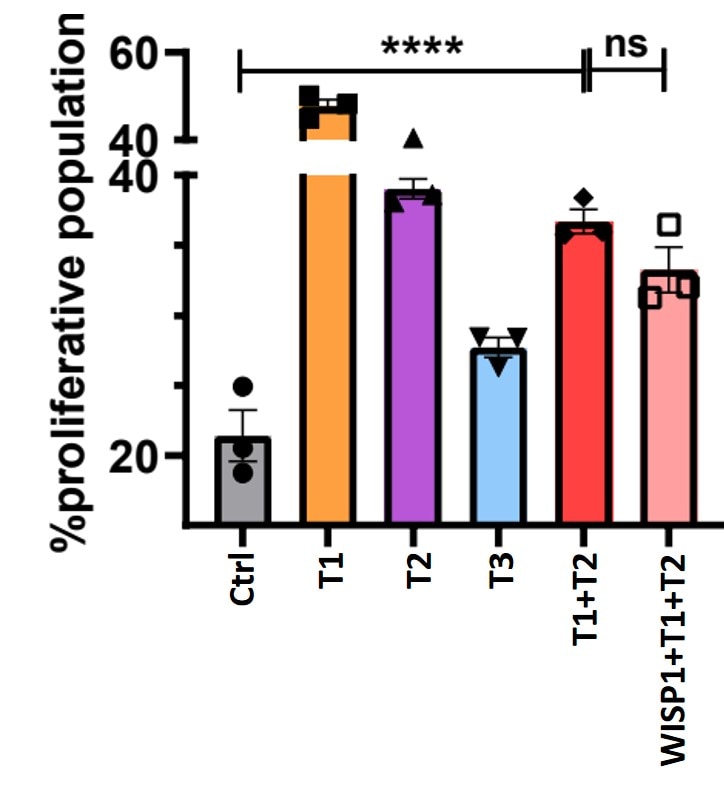Recombinant Mouse WISP-1/CCN4 Protein, CF Summary
- R&D Systems NS0-derived Recombinant Mouse WISP-1/CCN4 Protein (1680-WS)
- Quality control testing to verify active proteins with lot specific assays by in-house scientists
- All R&D Systems proteins are covered with a 100% guarantee
Product Specifications
Thr23-Asn367, with a C-terminal 10-His tag
Analysis
Product Datasheets
Carrier Free
CF stands for Carrier Free (CF). We typically add Bovine Serum Albumin (BSA) as a carrier protein to our recombinant proteins. Adding a carrier protein enhances protein stability, increases shelf-life, and allows the recombinant protein to be stored at a more dilute concentration. The carrier free version does not contain BSA.
In general, we advise purchasing the recombinant protein with BSA for use in cell or tissue culture, or as an ELISA standard. In contrast, the carrier free protein is recommended for applications, in which the presence of BSA could interfere.
1680-WS
| Formulation | Lyophilized from a 0.2 μm filtered solution in PBS. |
| Reconstitution | Reconstitute at 500 μg/mL in sterile PBS. |
| Shipping | The product is shipped at ambient temperature. Upon receipt, store it immediately at the temperature recommended below. |
| Stability & Storage: | Use a manual defrost freezer and avoid repeated freeze-thaw cycles.
|
Reconstitution Calculator
Background: WISP-1/CCN4
Mouse WISP-1 (Wnt-induced secreted protein-1; also named CNN4) is a 40 kDa, secreted, heparin-binding glycoprotein that is a member of the CCN (or CTGF/Cyr61/Nov) cysteine-rich protein family (1-6). It is synthesized as a 367 amino acid (aa) precursor that contains a series of structural homology modules. Following a 22 aa signal sequence, there is a 68 aa IGFBP-like domain (aa 53-120), a 66 aa von Willebrand factor type C (VWC) module (aa 121-186), a 41 aa TSP type I domain (aa 220-260) and a 75 aa, C-terminal cysteine knot motif (aa 273-347) (1, 6). The VWC module is associated with protein-protein interaction, the TSP domain binds sulfated glycoconjugates, and the cysteine knot mediates dimerization and receptor binding (4). It is likely that WISP-1 normally circulates as an 80 kDa homodimer (2). Multiple splice forms are reported for human WISP-1, but none for rodent (7-9). Mature mouse WISP-1 is 98%, 84% and 85% aa identical to rat, canine and human WISP-1, respectively. WISP-1 is expressed by fibroblasts and osteoblasts, and may contribute to fracture healing by promoting bone cell formation (1, 10, 11).
- Pennica, D. et al. (1998) Proc. Natl. Acad. Sci. USA 95:14717.
- Tanada, S. et al. (2001) Oncogene 20:5525.
- Brigstock, D.R. et al. (2003) J. Clin. Pathol. Mol. Pathol. 56:127.
- Desnoyers, L. (2004) Curr. Pharm. Des. 10:3913.
- Brigstock, D.R. (2003) J. Endocrinol. 178:169.
- Hashimoto, Y. et al. (1998) J. Exp. Med. 187:289.
- SwissProt Accession # O54775.
- SwissProt Accession # Q99PP0.
- SwissProt Accession # O95388
- French, D.M. et al. (2004) Am. J. Pathol. 165:855.
- Parisi, M.S. et al. (2006) Bone 38:671.
Citations for Recombinant Mouse WISP-1/CCN4 Protein, CF
R&D Systems personnel manually curate a database that contains references using R&D Systems products. The data collected includes not only links to publications in PubMed, but also provides information about sample types, species, and experimental conditions.
5
Citations: Showing 1 - 5
Filter your results:
Filter by:
-
Data-driven learning how oncogenic gene expression locally alters heterocellular networks
Authors: DJ Klinke Ii, A Fernandez, W Deng, A Razazan, H Latifizade, AC Pirkey
Nature Communications, 2022-04-13;13(1):1986.
Species: Mouse
Sample Types: Whole Cells
Applications: Bioassay -
Wisp1 is a circulating factor that stimulates proliferation of adult mouse and human beta cells
Authors: R Fernandez-, A García-Ala, Y Esteban, J Mir-Coll, B Serra-Nava, M Fontcubert, C Broca, M Armanet, A Wojtuscisz, V Kram, MF Young, J Vidal, R Gomis, R Gasa
Nat Commun, 2020-11-25;11(1):5982.
Species: Mouse
Sample Types: Whole Cells, In Vivo, Whole Tissue
Applications: Bioassay, In vivo assay -
WNT1-inducible signaling pathway protein 1 (WISP1/CCN4) stimulates melanoma invasion and metastasis by promoting the epithelial - mesenchymal transition
Authors: W Deng, A Fernandez, SL McLaughlin, DJ Klinke
J. Biol. Chem., 2019-02-05;0(0):.
Species: Human
Sample Types: Whole Cells
Applications: Cell Culture -
Aging Disrupts Muscle Stem Cell Function by Impairing Matricellular WISP1 Secretion from Fibro-Adipogenic Progenitors
Authors: L Lukjanenko, S Karaz, P Stuelsatz, U Gurriaran-, J Michaud, G Dammone, F Sizzano, O Mashinchia, S Ancel, E Migliavacc, S Liot, G Jacot, S Metairon, F Raymond, P Descombes, A Palini, B Chazaud, MA Rudnicki, CF Bentzinger, JN Feige
Cell Stem Cell, 2019-01-24;0(0):.
Species: Mouse
Sample Types: In Vivo
Applications: In Vivo -
MECHANICAL VENTILATION AUGMENTS POLY(I:C)INDUCED LUNG INJURY VIA A WISP1-INTEGRIN ?3 DEPENDENT PATHWAY IN MICE
Authors: Quan Li
Mol. Med., 2016-01-06;0(0):.
Species: Mouse
Sample Types: Whole Cells
Applications: Bioassay
FAQs
No product specific FAQs exist for this product, however you may
View all Proteins and Enzyme FAQsReviews for Recombinant Mouse WISP-1/CCN4 Protein, CF
Average Rating: 4.8 (Based on 5 Reviews)
Have you used Recombinant Mouse WISP-1/CCN4 Protein, CF?
Submit a review and receive an Amazon gift card.
$25/€18/£15/$25CAN/¥75 Yuan/¥2500 Yen for a review with an image
$10/€7/£6/$10 CAD/¥70 Yuan/¥1110 Yen for a review without an image
Filter by:





